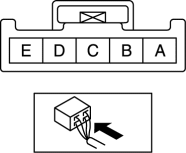Mazda CX-5 Service & Repair Manual: Steering Angle Sensor Inspection
1. Remove the column cover..
2. Connect the plus (+) end of a tester to steering angle sensor terminal A and the minus (-) end of the tester to terminal B (GND).

3. Switch the ignition ON (engine off or on).
4. Turn the steering wheel to the left and right.
5. Verify that the voltage from steering angle sensor terminal A to B (GND) is as indicated in the table.

-
If the voltage can be verified as indicated in the table, go to the next step.
-
If the voltage is not as indicated in the table, replace the clock spring..
6. Switch the ignition to off.
7. Connect the plus (+) end of a tester to steering angle sensor terminal C and the minus (-) end of the tester to terminal B (GND).

8. Switch the ignition ON (engine off or on).
9. Turn the steering wheel to the left and right.
10. Verify that the voltage from steering angle sensor terminal C to B (GND) is as indicated in the table.

-
If the voltage is not as indicated in the table, replace the clock spring..
 Steering Angle Sensor
Steering Angle Sensor
Purpose, Function
The steering angle sensor outputs the steering angle and steering angle reference
point during the period which the EPS control module performs initial learning
(approx. ...
 Turbine/Input Shaft Speed Sensor, Output Shaft Speed Sensor [Fw6 A EL, Fw6 Ax
EL]
Turbine/Input Shaft Speed Sensor, Output Shaft Speed Sensor [Fw6 A EL, Fw6 Ax
EL]
Purpose/Function
The turbine/input shaft speed sensor detects the rotation speed of the input
shaft (low clutch drum).
The output shaft speed sensor detects the rotation speed of the ...
Other materials:
Rear Differential Disassembly
WARNING:
The engine stand is equipped with a self-lock mechanism, however, if the
rear differential is in a tilted condition, the self-lock mechanism could become
inoperative. If the rear differential unexpectedly rotates it could cause injury,
therefore do not maintain the rear dif ...
Back Up Light Switch Inspection
1. Disconnect the negative battery cable..
2. Remove the front under cover No.2..
3. Remove the back-up light switch..
4. Verify that the continuity between the back-up light switch terminals is as
indicated in the table.
If not as indicated in the table, replace the back-up ...
High Mount Brake Light
Purpose
The high-mount brake light signals vehicles to the rear that the vehicle
is stopped.
Function
The high-mount brake light illuminates in conjunction with the operation
of the brake light switch.
Construction
The high-mount brake light is positioned on th ...
